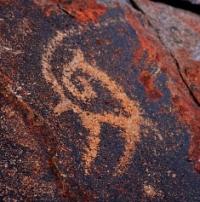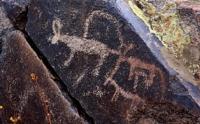Вы здесь
Rock Art Sites in Central Kazakhstan.



Small detour to Karaganda.
“The world is a book and those who do not travel read only one page”
Augustine of Hippo.
Quick trip from Dzhezkazgan to Karaganda.
Rock Art Sites in Kazakhstan 31 Central Kazakhstan Sites The middle part of Kazakhstan is occupied by a vast mountainous and steppe country – Saryarka (Kazakh Uplands). The unique landscape of Saryarka houses material evidence of the region’s ancient history left by ancient Stone Age hunters and Neolithic people, by shepherds and metal makers and by nomadic tribes from the Early Iron Age, Middle Ages, and modernity.
The evidence includes rock drawings, although such sites are less numerous on the map of the central part of Kazakhstan. The area of the main watershed Saryarka is mostly represented by mountain rocks not very suitable for engraving.
Those preserved are on isolated rocks at a great distance from one another, mainly on relatively smooth granites and diorites enclosed by natural ledges. Dravert P.L. Grotto in the Bayanaul Mountains is a famous rock art site, discovered in 1926 on the south-eastern shore of Zhasybay Lake by a Russian geologist and poet, after whom it was named.
Several humans facing the entrance of the cave were painted in ochre on its roof, so they could be seen from the depths of the niche. Paintings similar in contents and technique were also discovered later in other shelters in forested areas of the lake.
The main motifs on the walls and roofs include humans, but also isolated animals, birds, a bow with an arrow and unsophisticated geometric shapes or signs. It is difficult to date them; it is unlikely that most would date beyond the Bronze Age, a period of active peopling of the area with Andronovo and Begazy-Dandybaev culture tribes.
Rock paintings in central Saryarka were also made in another remarkable site –Tesiktas Grotto– located in the spurs of the Kyzyltau Mountains, in the upper reaches of one of the Sherubay-Nura River tributaries, far from Lake Bayanaul.
Although the natural environment is quite similar, Tesiktas represents a different type of landscape and rock paintings. Petroglyphs in Akbidayik and Olenty in the north-eastern periphery of Saryarka –a rare type of archeological site for the area– are among the northernmost rock art sites in Kazakhstan.
They represent the earliest examples of steppe-tribes’ rock art from the 3rd to the first half of the 2nd millennium BC, which permits us to trace some pictorial traditions of the Bronze Age common in the southern regions of Saryarka (Northern Near Balkhash Area, Ylitau) and farther in the Karatau and Chu-Ili Mountains.
Authority:
“Rock Art Sites in Kazakhstan”. Alexey E. Rogozhinskiy.
Photo by
Alexander Petrov.







